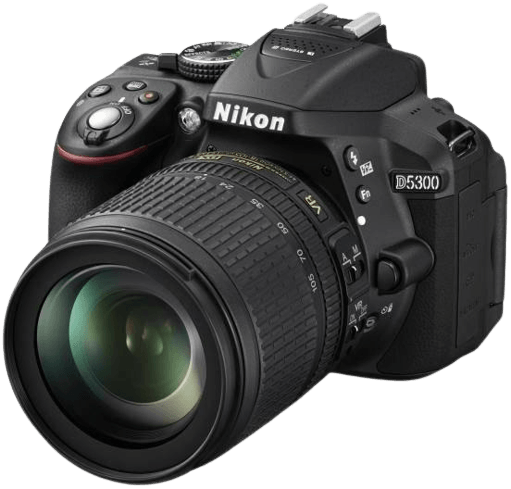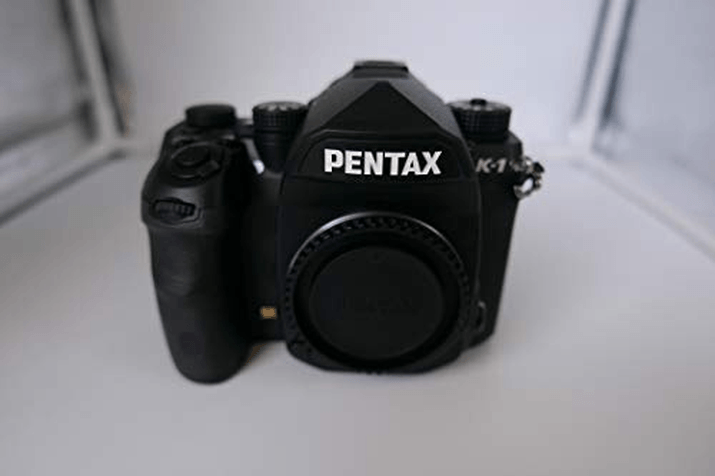Nikon D5300 vs Pentax K-1 Comparison
Nikon D5300

Pentax K-1

The Pentax K-1, with a score of 77/100, outperforms the Nikon D5300, which has a score of 57/100. Both cameras are DSLRs, with the Nikon D5300 announced in 2013 and the Pentax K-1 in 2016. They share similar dimensions, but the Pentax K-1 is heavier at 1010g compared to the Nikon D5300’s 480g.
The Pentax K-1’s higher score indicates its superior performance and features, which justifies its higher launch price of $1800 compared to the Nikon D5300’s $800. The Nikon D5300, however, has the advantage of being lighter and more affordable, making it an attractive option for beginners or those on a budget.
Taking these factors into consideration, the Pentax K-1 is the better choice for experienced photographers seeking advanced features and performance, while the Nikon D5300 is a suitable option for those who prioritize affordability and portability.
Nikon D5300 vs Pentax K-1 Overview and Optics
The Pentax K-1 outperforms the Nikon D5300 in optics, with a score of 85/100 compared to the D5300’s 65/100. Both cameras have a CMOS sensor and different processors, with the D5300 using Expeed 4 and the K-1 using Prime IV. They also share the same shooting speeds, 5 for the D5300 and 4.4 for the K-1.
The Pentax K-1 excels in several aspects. It has a higher megapixel count at 36.4 compared to the D5300’s 24.2, which results in sharper and more detailed images. The K-1 also has a better DXOMARK sensor score of 96, while the D5300 scores 83. This indicates superior image quality in the K-1. Additionally, the K-1 has a full-frame sensor size, offering a larger field of view and better low-light performance than the D5300’s APS-C sensor. The K-1 also features image stabilization, which the D5300 lacks, allowing for steadier shots in various conditions.
On the other hand, the Nikon D5300 has a few advantages. It has a slightly faster shooting speed of 5 compared to the K-1’s 4.4, which can be beneficial in capturing fast-moving subjects. The D5300 also uses the Nikon F DX lens mount, which offers a wider range of lens compatibility than the Pentax KAF mount.
While the Nikon D5300 has its merits, the Pentax K-1 ultimately offers superior optics due to its higher megapixel count, better DXOMARK sensor score, full-frame sensor size, and image stabilization. The D5300 may be a suitable choice for those prioritizing shooting speed and lens compatibility, but the K-1 is the clear winner in terms of overall optical performance.
Nikon D5300 vs Pentax K-1 Video Performance
The Nikon D5300 and the Pentax K-1 both receive a video score of 70/100, indicating that they have comparable video capabilities. Both cameras share several common specifications, including Full HD video resolution, maximum video dimensions of 1920 x 1080, a maximum video frame rate of 60fps, and built-in time-lapse functionality.
Although the overall video scores are equal, each camera has its unique strengths. The Nikon D5300 stands out for its user-friendly interface and lighter weight, making it a more convenient option for those who prioritize ease of use and portability. This camera is ideal for casual videographers and beginners who want a reliable and straightforward camera for capturing high-quality video.
On the other hand, the Pentax K-1 offers robust build quality and weather resistance, making it a more durable choice for outdoor and adventure videography. This camera is better suited for experienced videographers who need a rugged device that can withstand harsh environments and demanding conditions. The Pentax K-1 also has a reputation for producing sharp and detailed images, which may translate to higher quality video output.
Both the Nikon D5300 and the Pentax K-1 have their advantages and cater to different user preferences. The D5300 is a more accessible and portable option, while the K-1 is built to endure and perform in challenging conditions. Despite their distinct strengths, both cameras deliver Full HD video resolution and share essential video features, making them capable choices for a variety of videography needs.
Nikon D5300 vs Pentax K-1 Features and Benefits
The Pentax K-1 emerges as the winner in the features comparison with a score of 59/100, while the Nikon D5300 scores 46/100. Both cameras share several specifications, including a 3.2-inch screen size, 1037000-dot screen resolution, flip screen, GPS, WIFI, and lack of Bluetooth connectivity.
The Pentax K-1 outperforms the Nikon D5300 in several aspects. Its superior feature score reflects its better overall capabilities. Additionally, the K-1 offers a more robust and durable build quality, making it a more reliable option for professional photographers who require a rugged camera for various shooting conditions.
On the other hand, the Nikon D5300 has certain advantages over the Pentax K-1. It is a lighter and more compact camera, making it easier to carry and handle during long photography sessions. This can be a significant factor for users who prioritize portability and convenience.
In comparing the features of both cameras, the Pentax K-1’s higher score reflects its superior performance and build quality, making it a more suitable choice for professional photographers. However, the Nikon D5300’s lighter and more compact design may appeal to users who value portability and ease of use. Ultimately, the choice between these two cameras depends on the individual user’s priorities and preferences in terms of features, performance, and convenience.
Nikon D5300 vs Pentax K-1 Storage and Battery
The Pentax K-1 outperforms the Nikon D5300 in storage and battery, scoring 68/100 compared to the D5300’s 29/100. Both cameras accept SD, SDHC, and SDXC memory cards, but the K-1 has two memory card slots, while the D5300 has only one. Additionally, the K-1’s memory cards are UHS-I compatible.
The K-1 also boasts a longer battery life of 760 shots, while the D5300 lasts for 600 shots. The Pentax K-1 uses a D-LI90 battery, while the Nikon D5300 uses an EN-EL14a battery. Neither camera supports USB charging.
While the D5300 does not surpass the K-1 in storage and battery, it still offers decent performance with its single memory card slot and 600-shot battery life. However, the Pentax K-1 clearly excels in this category with its dual memory card slots, UHS-I compatibility, and longer battery life, making it the superior choice for photographers requiring more storage and power.
Nikon D5300 vs Pentax K-1 – Our Verdict
Are you still undecided about which camera is right for you? Have a look at these popular comparisons that feature the Nikon D5300 or the Pentax K-1:

